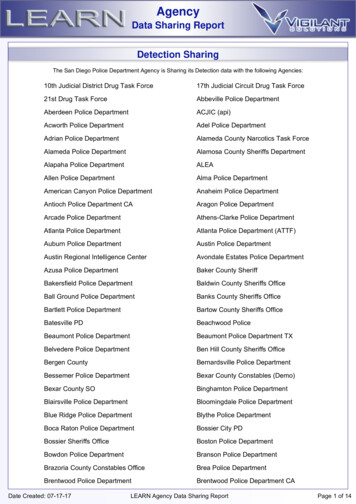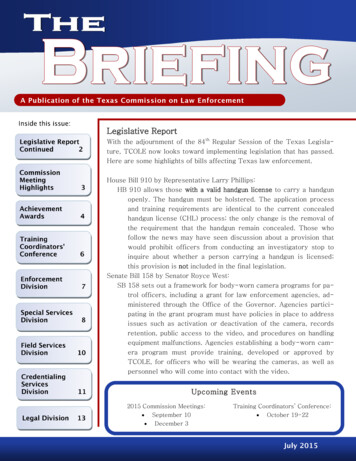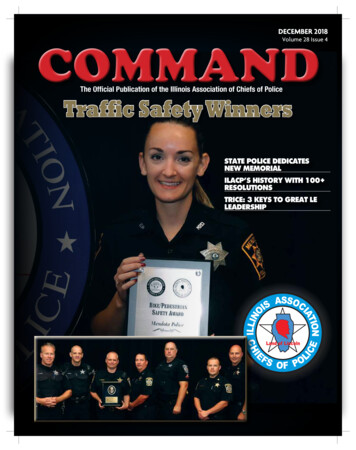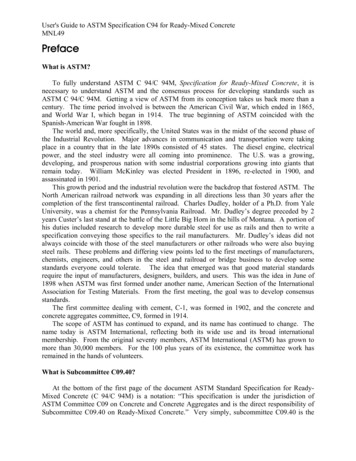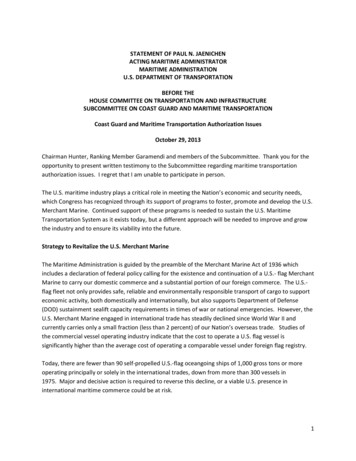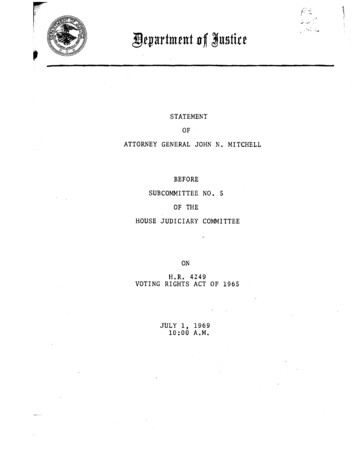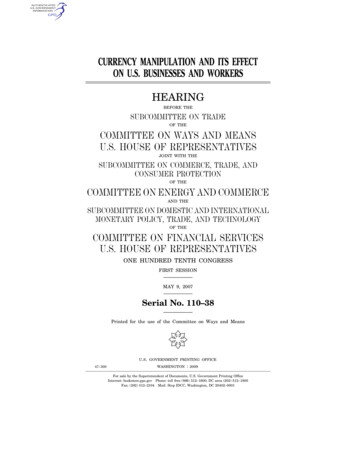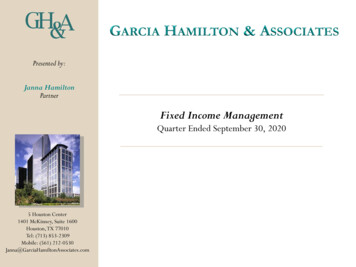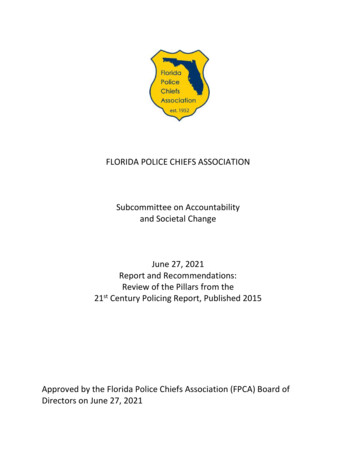
Transcription
FLORIDA POLICE CHIEFS ASSOCIATIONSubcommittee on Accountabilityand Societal ChangeJune 27, 2021Report and Recommendations:Review of the Pillars from the21st Century Policing Report, Published 2015Approved by the Florida Police Chiefs Association (FPCA) Board ofDirectors on June 27, 2021
Table of ContentsIntroduction – Executive Summary2Pillar One: Building Trust8899 Promoting a culture of treating people with dignity and respectStandardizing a culture of transparency and accountabilityPositive nonenforcement community engagementResearch crime-fighting strategies that undermine or build public trust with the goal ofeliminating strategies that undermine public trustIntentionally cultivate a diverse and more inclusive workforceCommunicationHumanizing Law Enforcement PersonnelYouth OutreachEngage with Law EnforcementEncourage RelationshipsCollaborationEmpathyCommunity RecognitionCommunity Dialogue Regarding Law EnforcementCitizens Police AcademyProper FundingPillar Two: Policy & Oversight 13131314141414151515161616Community input and involvementUse of ForceNonpunitive peer review of critical incidents for “near misses or “sentinel events”Scientifically supported identification proceduresDemographic data on all detentionsMass demonstration policies for all agenciesLocal civilian oversight and advisory panels/trainingsConsent and informed search and seizureOfficer identification and reason for stopsProhibit profiling and discrimination, collect data, all agencies should have a policyEncourage shared services between jurisdictionsEncourage local agencies to us the National Register of Decertified OfficersRecommend that any officer fired while under investigation have their certification statuschanged to ‘pending’16Encourage law enforcement to have a community relations or advisory board17Pillar Three: Technology & Social Media 99101010101111111111121218New Technology standards for compatibility and interoperability18Privacy concerns, civil rights and civil liberties should be addressed in any new technologyBeing utilized by a law enforcement agency18Accessibility to technology. Designed considering local needs and people with specialNeeds18Body-worn cameras (also referred to as BWC programs) and other emerging technologies19Public records laws – update to keep up with emerging technologies19Transparency and accessibility for community through technology19
Develop new less than lethal technology Encourage community involvement in social media20Recommend that parents, school administrators, teachers, and youth-serving organizationsSupport law enforcement’s efforts to enhance positive youth engagement at school andIn the community21Pillar Four: Community Policing with Community Collaboration Recommend that community policing become the guiding philosophy and practice of thedepartmentExamine the use and cost-savings that non-sworn personnel may provide and its impacton resource deploymentUtilize community organizations as resource tools in crime prevention effortsPillar Five: Training & Education High quality training and training innovations hubsEmbrace a shared responsibility and accountability approach to training of both officersand community membersLeadership training for all officersPostgraduate program of policing for senior executives is highly encouragedIncorporate the following in basic recruit and in-service trainingHigher education for law enforcement officers is highly encouraged during their careerUse of technology to improve access to and quality trainingImprove field training officers (FTO) programsImprove the opportunities for communities to be empowered to assist in crime preventionand fear reductionPillar Six: Officer Wellness & Safety 20Encourage agencies to develop platforms for the anonymous reporting of tips and criminal activity;ensure the community understands this reporting to alleviate concerns regarding ceted officer safety and wellness initiative27Consider scientifically supported shift lengths27Tactical first aid kit and training28Collect information on injuries and near misses as well as officer deaths28Require officers to wear seat belts and bulletproof vests (ensure all officers are officers areprovided vests)28Smart car technology to reduce accidents28Create peer support teams – establish policies that allow for multiple options of support toExternal support networks, anonymous discussions/groups (as appropriate based upon caselaw and contractual obligations/insurance requirements?)29Enhance community participation in officer safety29
I.Executive hange (“Subcommittee”) wascreated to study the intersectionbetween law enforcement and thecommunity and determine howtheFloridaPoliceChiefsAssociation’s members can betterserve its customers – thecommunity. Comprised of lawenforcement executives, membersof the community, and subjectmatter experts, the Subcommitteeworkedcollaborativelytoaccomplish a lot during its shorttenure, beginning with theSeptember 2020 publication Useof Force Policy and Related Issues.Subcommittee Members QuotesChief Anthony HollowaySt. Peterburg Police Department“This Subcommittee has produced reports and providedguidance that are applicable to agencies of all sizes anddemographics. By working together, utilizing theseguidelines, we will be acting as one agency with one voice.”Dr. Randy NelsonProgram Director, Bethune-Cookman University Center forLaw and Social Justice“Law enforcement needs to be able to engageour black and brown communities on non-law enforcementissues. If they don’t, we will never get over the stigma ofthese communities associating the police with negativeactions. Communities and the police have equalresponsibility for this engagement. Only then can lastingpartnerships that improve public safety be developed.”Now, this next report representsthecommunicationstheSubcommittee held to review sixmain topic areas commonlyreferred to as “pillars” from theFinal Report of the Presidents TaskForce on 21st Century Policing,Washington, DC Office ofCommunity Oriented PolicingServices. These pillars are:Chief Jeffrey PearsonSatellite Beach Police DepartmentImmediate Past President FCPA“I was impressed by the willingness ofall the Subcommittee members to have difficultconversations with each otherto identify and address issuesimpacting the trust in law enforcement. It is the trustbetween law enforcement and the communities that theyserve that is the single most important factor in effectivepolicing and public safety strategies.” BuildingTrust&Legitimacy Policy & Oversight Technology & Social Media2
Community Policing & Crime Reduction Training & Education Officer Wellness & SafetyAs noted in the FPCA’s Use of Force report, nothing contained in this report mayset a state-wide standard nor form a basis to limit the otherwise lawfuldevelopment of individual law enforcement agency policies, or the lawful use ofotherwise lawful techniques.II.Composition of the SubcommitteeThe Subcommittee was created by former FPCA President Ken Albano, Chief,Temple Terrace Police Department, who memorialized the collective commitmentof the Florida Police Chiefs Association to real, meaningful, lasting change. Throughhis leadership and that of 2020-2021 President Jeff Pearson, Chief, Satellite BeachPolice Department, and former FPCA Executive Director Amy Mercer, designatedmembers of the association entered a partnership with prominent communitymembers to explore ways to implement change. Subcommittee members were: Chair: Chief Anthony Holloway – St. Petersburg Police DepartmentCommunity Leaders: T. Willard Fair, President and CEO, Urban League of Greater Miami Rev. Watson L. Haynes, II, President & CEO, Urban League of PinellasCounty Paula Hoisington, Chairwoman, Central Florida Urban League Rev. Arthur Jackson, III, Senior Pastor, Antioch Missionary BaptistChurch, Miami Gardens Dr. Randy Nelson, Program Director, Bethune-Cookman UniversityCenter for Law and Social Justice Dr. Shirley Plantin, Executive Director, Miami-Dade County CommunityRelations Board Kareem J. Spratling, Shareholder, Bryant Miller Olive P.A. Sabrita Thurman-Newby, Co-Chair, The Neighborhood First Initiative,Tallahassee Marilyn Turman, SPC Corporate Trainer, Event Coordinator, CommunityActivist3
Subcommittee MemberQuotes Kerry Wiggins, Educator and Coach, CityCommissioner, Sanford Pastor Rodney Wilkinson, Lead Pastor,Gospel Fellowship, Boynton Beach“After reading these reports by theSubcommittee, I hope that lawenforcement leaders will firstunderstand that reform and supportingthe police aren’t mutually exclusive. Anyorganization that doesn’t constantlyevolve to support the people you serve,is one that is destined to fail. Reform isnecessary. I hope officers and lawenforcement leaders will accept theserecommendations knowing that thepeople on this committee absolutelysupport them and understand thatpolicing is one of the most difficult jobsin the world. Communities need toreview these recommendations andacknowledge that most officers are goodand want to do the right thing. Theyneed to be just as likely to uplift them asthey are to disparage them.”Law Enforcement Members and SubjectMatter Experts: Chief Charles Broadway, Clermont PoliceDepartment Chief Terri Brown, Florida State UniversityPolice Department Major David De La Espriella, Miami BeachPolice Department and President, Miami-DadeCounty Association of Chiefs of Police Chief Brian Dugan, Tampa PoliceDepartment Chief Michael Gregory, Boynton BeachPolice Department J. David Marsey, General Counsel, andsubject matter expert on use of force andpolicy development, Florida Police ChiefsAssociation Assistant Commissioner Jennifer Pritt,Florida Department of Law Enforcement(retired February 2021) Chief Orlando Rolón, Orlando PoliceDepartment Chief Daniel Slaughter, Clearwater PoliceDepartment Chief Cecil Smith, Sanford PoliceDepartment Chief Dexter Williams, Miramar Policedepartment and president, Broward CountyAssociation of Chiefs of PoliceKareem J. SpratlingShareholder, Bryant Miller Olive P.A.Major David De La EspriellaMiami Beach Police Department andPresident, Miami-Dade CountyAssociation of Chiefs of Police“My experience throughout this processwas always positive. This committee wasdifferent than others that I have servedon because the community memberswere such an integral part of theconversation. The product shows howengaged they were. I look forward totaking the reports back to my region andhelping to continue the dialog. Iencourage everyone to continue to buildthis bridge between the police and thecommunity – the work on thisrelationship is never really done.”4
III.TaskingThe Subcommittee had wide latitude to determine its own course and scopethrough the cooperative engagement of its members. During this collaborativeprocess, and in recognition of the unanimous desire to make a prompt andmeaningful statement, the Subcommittee decided to adopt a multi-phase process.First, the Subcommittee determined its mission statement and goals. Second, itidentified recommendations regarding use of force policies and related issues topresent to the FPCA Board for adoption and dissemination (which was approvedand published as the Use of Force Report). Third, it determined that a broaderdiscussion on societal issues impacting law enforcement officers, agencies and theircommunities warranted a more detailed and comprehensive dialog. As previouslystated, the “pillars” from the “The Final Report of The President’s Task Force on 21stCentury Policing,” published May, 2015, became the framework for this discussion.As they worked through each of the “pillars” in that report, they also referencedother publications for additional ideas. The publications below may be referencedor quoted in the attached report: IACP National Policy Summit on Community-Police Relations: Advancing aCulture of Cohesion and Community Trust January 2015 IACP Trust Initiative Report October 2018 Lum, C., Koper, C.S., Gill, C., Hibdon, J., Telep, C., & Robinson, L. (2016) AnEvidence-Assessment of the Recommendations of the President’s Task Forceon 21st Century Policing – Implementation and Research Priorities PERF The Workforce Crisis and What Police Agencies Are Doing About ItSeptember 2019 PERF Guiding Principle On Use of Force March 2016 CJSTC Community Safety Advisory Workgroup Report Strengthening theBonds of Trust between Law Enforcement and the Public: Community SafetyRecommendations May 11, 2017 Congressional Research Service Public Trust and Law Enforcement – ADiscussion for Policymakers Updated December 13, 2018 Parramore Community Safety and Engagement Action Plan Feb 10, 2021,Prepared by Bethune-Cookman University Center for Law and Social Justice,for the City of Orlando Police Department5
IV.MethodologyAt the outset, the Subcommittee prepared itsmission statement:The Florida Police Chiefs Association’sSubcommittee on Accountability and SocietalChange, as composed of law enforcement andcommunity leaders, will review reformrecommendations, and develop a series ofproposals that could be implemented at thelocal and state level to enhance trust, ensuretransparency and accountability, andstrengthen relationships between the policeand the communities they serve.Once its mission was identified, theSubcommittee held its first meeting on June15, 2020, to prepare a preliminary plan andtimeline. Of the utmost importance was theidentification of community members to aidthe Subcommittee on its Mission. Toaccomplish that goal, law enforcementmembers identified community members toserve alongside them (listed on page 3). Aftercompleting and publishing their Use of Forcereport, the group continued meeting to discussadditional topics of interest.V.RecommendationsBecause the Subcommittee’s intent was toengage in conversations and formulateconsensus recommendations, this report isformatted to align with the substantive issuesand recommendations associated with the sixpillars in “The Final Report of The President’s6Subcommittee MemberQuotesChief Terri BrownFlorida State UniversityPolice Department“My hope is that law enforcementleaders will read these reports andrealize there is always room forimprovement. Closing the disconnectbetween police and the communityrequires involving the community fromthe start.”Paula HoisingtonChairwoman, Central FloridaUrban League“This report is a beginning to buildingthat bridge of openness andtransparency, to build the bridge ofunity so that both sides can worktogether to build bigger, stronger, safercommunities. Working together withone common goal, to make thecommunities safer.”Chief Cecil SmithSanford Police Department“We had in-depth conversationsabout what law enforcement andcommunities should be doing to makecommunities safer. It was alwaysenlightening to listen to our stakeholders describe what they feel thepolice should be doing and how theyshould be doing it. I was looking tosee how I could modify my agency tofit within the recommendations wecollectively made.”Chief Dan SlaughterClearwater Police Department“This document should be used as aroadmap to stimulate conversation.We all want the same thing, we wantour communities to be safe and freeof crime.”
Task Force on 21st Century Policing.” Both the FPCA and the Subcommitteerecognize that many more action items could have been identified under each ofthese pillars, and the list provided in this document is not intended to be exhaustivebut is simply a starting place for moving recommendations into action. TheSubcommittee further prioritized action items within the framework ofresponsibility. Certain recommendations are within the responsibility of lawenforcement while others are within the domain of communities, and others stillare collective responsibilities. A color-coded legend identifies these entities withprimary, but not exclusive, responsibility. All action Items are red, all lawenforcement items are blue, all community items are green, and both are in purple.VI.ConclusionAlthough the Subcommittee addressed many issues during its year of meetings, therecommendations and dialog of the group are just beginning. The information andideas exchanged during the Subcommittee meetings is indicative of the success thatmay be had at the local level if law enforcement administrators engage with theircommunities. The Subcommittee recommends that local law enforcement agenciesand their communities use this document to start or continue this conversation.FPCA is dedicated to working with our communities to ensure that an open dialogueon law enforcement practices continued even in the wake of horrible tragedies, toinclude the death of George Floyd, and the FPCA Subcommittee on Accountabilityand Social Change is a visible manifestation of that continuing dedication. TheSubcommittee hosted dozens of meetings with community leaders since last June todetermine how we can better serve our customers – the community. We expect ourmembership to continue these conversations as they represent some of the finestlaw enforcement leaders in the nation.The Subcommittee would also like to recognize the Florida Legislature’s leadership,notably Speaker of the House Chris Sprowls and Senate President Wilton Simpson,and Florida Governor Ron DeSantis in moving forward impactful legislation duringthe 2021-22 Session to address the practices and accountability of law enforcementand correctional officers. The community and law enforcement leaders on thisSubcommittee, as well as FPCA membership, welcome reform measures that arefactual and balanced, ever mindful of the dedication and sacrifice of lawenforcement officers, but equally committed to public safety and accountability.7
8Legend: Law Enforcement (Blue) / Community (Green)/ Both (purple)/Action Items (Red)Pillar One: Building Trust: The recommendations and action items in this pillar focus onprocedural justice and its link to respect of the police by the community, which in turn shouldalso increase compliance with the law and community support for crime preventionstrategies. A key concept is that procedural justice is a foundational value withindepartments, meaning all officers and commanders must model the behaviors associatedwith procedural justice with each other, during individual contacts and with the community. Promoting a culture of treating people with dignity and respectAction Items:o Create an environment in which leadership commits to and models the behaviorexpected of the entire agency.o Incorporate training for all levels, including command staff, on fair, unbiasedpolicing, human engagement, relationship building and procedural justice.o Law enforcement employees, not just command staff, should be involved in theprocess of developing these trainings as well as policies and procedures addressingprocedural justice, transparency, and accountability.o Adopt procedural justice as the guiding principle for internal and external policiesand practices to guide their interactions with the citizens they serve. This includesthe following pillars and actions: Fairness and consistency in rule application Voice and representation in the process Transparency and openness in the process Impartiality and unbiased decision-makingFor police officers, procedural justice amounts to four basic actions.1. Treat people with respect.2. Listen to what they have to say.3. Make fair decisions.4. Explain your actions.o Leadership must create an environment where there are significant models ofpositive behavior.o Ensure that officers have the knowledge and skills to be culturally responsive andto treat each person with dignity and respect. Standardizing a culture of transparency and accountabilityAction Items:o As appropriate, make department policies publicly accessible.o Consider regular posting on the department website information about arrests,traffic stops, use of force and other law enforcement data aggregated by
9demographics. This will be highly contingent of resources necessary to compile anddisplay in a meaningful manner this type of data.o When a serious use of force incidence or a police misconduct case occurs, agenciesshould communicate with citizens and the media swiftly, openly, and neutrally,respecting areas where the law requires confidentiality. Positive nonenforcement community engagementAction Items:o Create forums for the community to have easy and ready access to officers todiscuss their concerns.o Include both recognized community leaders as well as informal leaders.o Highlight and publicize activities and interactions that highlight the community andlaw enforcement officers working together to achieve common goals.o Consider adjusting patrol schedules to allow time for interactions with thecommunity, this could include community service projects.o Survey your communities to discover where they would like to most see officersplugged into non-enforcement endeavors. Research crime-fighting strategies that undermine or build public trust with the goal ofeliminating strategies that undermine public trust.Action Items:o Consider surveying membership to ask officers what they think of policingstrategies in terms of helping or hurting their ability to connect with the public.o As appropriate, consider involving members of the community in the process ofdeveloping and evaluating specific crime prevention strategies and tactics.o The impact on the community trust in law enforcement should be a considerationwhenever practical in developing tactical operations. Intentionally cultivate a diverse and more inclusive workforceAction Items:o Develop and implement programs to recruit and retain diverse officer candidates.o Identify barriers that prevent diverse candidates from applying or being selected;consider refining certain policies that may be hindering the recruitment, selectionor retention of a diverse workforce.o Work with community members (i.e., teachers, coaches, ministry, etc.) to inspireyouth to participate in Explorer and other programs that could lead to lawenforcement employment opportunities.o Identify and share best practices and model programs for enhancing diversity (asfound on IACP and other forums); routinely seek opportunities to publicize “whatworks” in specific Florida communities.o Consider partnering with schools (K-12 and post-secondary) and the community toenlist assistance with both recruitment campaigns as well as engage specificmembers to help with portions of the selection process.
10 Communication – Communication with law enforcement personnel.Action Items:o Invite meaningful engagement with the police department.o Advocate for progressive changes but manage expectations based on the factorsoutside the control of individual officers and police leadership.o Act as committed, constructive critics as well as champions of the department andofficers. Humanizing Law Enforcement Personnel – Community acknowledgement that lawenforcement personnel are human and that overwhelmingly, errors made by lawenforcement personally are due to human error, not bad intent, or criminal intent.Action Items:o Find ways through community forums to discuss how progressive lawenforcement training and officer discipline is in Florida.o As appropriate, be prepared to counter misrepresentations or labeling ofspecific actions when they become the focus of community unrest. Youth Outreach – Encouragement of community youth to interact with law enforcementpersonnel with the aim of changing the way community youth see law enforcement,creating more opportunities for positive interactions between youth and lawenforcement personnel and ultimately increasing racial and ethnic diversity within lawenforcement and consequently within the communities that they serve.Action Items:o Provide youth with a comprehensive picture of who the police are and what theydo.o Participate in problem solving efforts and discussion of crime reducing strategiesaimed specifically at targeting juvenile crime.o Help to identify youth leaders in the community that would be good candidates forspecific police/youth engagement programs.o Seek officers to serve as community coaches for youth sports or other youthactivities.o Ask the agency that has assigned school resource officers in your communityschools to consider allowing these same officers to participate in specificcommunity events outside the scope of their SRO duties (funding dependent) – forexample, YMCA, Boys Clubs, Girls Clubs, etc. Champion, with elected officials,increases in agency funding solely for these purposes. Engage with Law Enforcement – Invite and include law enforcement in community eventsas an integral part of the community, with the goal of the community getting to know theofficers patrolling that community as an asset, true member and part of the communityand not just a uniform. Invite law enforcement to assist in planning community events tobuild partnerships and further encourage trust and relationships.
11 Action Items:o Show public and private support for law enforcement sponsored events andactivities to include citizen academies, police athletic leagues, andaward/promotional ceremonies.o Work with law enforcement to ensure that crime-reducing resources and tacticsare being deployed that mitigate unintended consequences.Encourage Relationships – Be purposeful in encouraging all community members to buildrelationships with law enforcement, attempt to form a true partnership.Action Items:o Stop and speak with their law enforcement officers on a regular basis, not just inconnection with a crime.o Demonstrate respect towards officers around your contacts, particularly, children,as they will be most impacted by your words about and towards law enforcement.Collaboration – When a community crisis occurs, if possible, first attempt to collaboratewith law enforcement on a solution.Action Items:o Be prepared to deal with some community members that may not be aware of allthe facts, regarding a specific crime event or of a law enforcement/citizen contact.o Engage and mobilize members of the community that have attended citizen policeacademies, as well as those that serve as ad-hoc and informal leaders, to helpfacilitate a deeper understanding of police tactics and to offset fear ormisunderstanding of police actions.Empathy – Have empathy for law enforcement personnel. Recognize that it is a difficultjob that regularly requires uncomfortable conversations and difficult interactions.Action Items:o Publicly recognize and thank law enforcement officers when you encounter them.o Use your voice regarding positive encounters (traffic stop, response to anemergency, school resource officer meeting, etc.). Negative encounters can occurand typically they spread farther and wider, therefore we need to be intentionalabout spreading positivity.o When officers are injured or killed in the line of duty, remember this officer wassomeone’s father/mother, son/daughter, sister/brother; try to provide immediateoutreach to the agency and offer to provide some form of assistance asappropriate.Community Recognition – Consider community awards/public recognition within theimmediate community to recognize the good work of law enforcement personnel.Community Dialogue Regarding Law Enforcement – Create a community led group onlaw enforcement to encourage ongoing community conversations, not just in times ofcrisis, through meetings and even social media groups to discuss law enforcement in thecommunity. Do not solely focus on the negative. Invite law enforcement personnel whenappropriate. Use facts (i.e., data and analytics) to form the basis for discussion, not only
12perception. Discussions regarding negative law enforcement encounters should be heldwhen appropriate, but also do the same for members of the community. While it isnecessary to hold law enforcement professionals accountable when appropriate, it isequally necessary for community accountability when appropriate.Action Items:o Engage before a crisis, not when one is unfolding.o Develop a template or “how to” model for community action groups that can beutilized by those communities seeking to do this for the first time.o Hold a “practice” meeting with a smaller group and law enforcement leaders todevelop the rules of engagement for moving forward.o Also, highlight extraordinary acts by law enforcement and members of thecommunity that further a safe and secure community. Citizens Police Academy – Encourage your community law enforcement to have a CitizensPolice Academy or similar program. Encourage leaders in the community of all ages, races,genders, sexual orientation, and religious beliefs, to participate to gain a betterunderstanding of the job of a law enforcement officer, to provide law enforcement witha better perspective of your community and to build long-term relationships betweenyour community and law enforcement.Action Items:o Work with your Chiefs to secure the necessary funding and support to create andmaintain these citizen programs.o These programs work best when there is a diverse group of citizens attending andthat the numbers justify the cost to run the program; attend yourself, recruit othersand help emphasize the importance of these programs. Proper Funding – There are law enforcement agencies that would like to incorporatepolicies and procedures that are scientifically proven to better community policing butcannot do so due to budgetary constraints (i.e., body cameras, less lethal weapons, andmore officers).Action Items:o Encourage your local elected officials with your law enforcement leaders, to helpensure your law enforcement agencies are properly funded.o Do not allow the “defund the police” conversation to go unchecked. Ask questionsof city, county, state,
Citizens Police Academy 12 Proper Funding 12. Pillar Two: Policy & Oversight 13 Community input and involvement 13 . Temple Terrace Police Department, who memorialized the collective commitment of the Florida Police Chief s Association to real, meaningful, lasting change. Through
